Automatic Mode-Matching Method for MEMS Gyroscope Based on Fast Mode Reversal
Abstract
1. Introduction
2. Impact of Frequency Spilt on FTR Closed-Loop Detection
2.1. Cobweb-like DRG
2.2. FTR Closed-Loop System and Transfer Function
2.3. Impact of Frequency Spilt on System Response
3. Automatic Mode-Matching Based on Mode Reversal
4. Experiment and Discussion
4.1. Experimental Platform
4.2. Response Testing at Different Frequency Splits
4.3. Frequency Self-Matching Test
4.4. Temperature Testing
5. Conclusions
Author Contributions
Funding
Data Availability Statement
Conflicts of Interest
References
- Tatar, E.; Mukherjee, T.; Fedder, G.K. Stress effects and compensation of bias drift in a MEMS vibratory-rate gyroscope. J. Microelectromechanical Syst. 2017, 26, 569–579. [Google Scholar] [CrossRef]
- Jia, J.; Ding, X.; Qin, Z.; Ruan, Z.; Li, W.; Liu, X.; Li, H. Overview and analysis of MEMS Coriolis vibratory ring gyroscope. Measurement 2021, 182, 109704. [Google Scholar] [CrossRef]
- Bashir, U.; Bazaz, S.A.; Saleem, M.M.; Shakoor, R.I.; Tariq, M.O.; Kumar, P. Design and analysis of mode-matched decoupled mass MEMS gyroscope with improved thermal stability. Meas. Sci. Technol. 2024, 35, 086319. [Google Scholar] [CrossRef]
- Fan, Q.; Zhou, Y.; Liu, M.; Lin, C.; Su, Y. A MEMS rate-integrating gyroscope (RIG) with in-run automatic mode-matching. IEEE Sens. J. 2022, 22, 2282–2291. [Google Scholar] [CrossRef]
- Sonmezoglu, S.; Alper, S.E.; Akin, T. An automatically mode-matched MEMS gyroscope with wide and tunable bandwidth. J. Microelectromechanical Syst. 2014, 23, 284–297. [Google Scholar] [CrossRef]
- Sung, S.; Sung, W.T.; Kim, C.; Yun, S.; Lee, Y.J. On the mode-matched control of MEMS vibratory gyroscope via phase-domain analysis and design. IEEE ASME Trans. Mechatron. 2009, 14, 446–455. [Google Scholar] [CrossRef]
- Sharma, A.; Zaman, M.F.; Ayazi, F. A Sub-0.2°/hr bias drift micromechanical silicon gyroscope with automatic CMOS mode-matching. IEEE J. Solid. State Circuits 2009, 44, 1593–1608. [Google Scholar] [CrossRef]
- Yesil, F.; Alper, S.E.; Akin, T. An automatic mode matching system for a high Q-factor MEMS gyroscope using a decoupled perturbation signal. In Proceedings of the 2015 Transducers—Vol. 2015 18th International Conference on Solid-State Sensors, Actuators and Microsystems (TRANSDUCERS), Anchorage, AK, USA, 21–25 June 2015; pp. 1148–1151. [Google Scholar]
- Xu, L.; Li, H.S.; Yang, C.; Huang, L. Comparison of three automatic mode-matching methods for silicon micro-gyroscopes based on phase characteristic. IEEE Sens. J. 2016, 16, 610–619. [Google Scholar] [CrossRef]
- Ren, J.; Zhou, T.; Zhou, Y.; Li, Y.; Su, Y. A real-time automatic mode-matching method based on phase-shifted virtual Coriolis force for MEMS disk resonator gyroscope. IEEE Sens. J. 2023, 23, 28673–28683. [Google Scholar] [CrossRef]
- Ruan, Z.; Ding, X.; Qin, Z.; Jia, J.; Li, H. Automatic mode-matching method for MEMS disk resonator gyroscopes based on virtual Coriolis force. Micromachines 2020, 11, 210. [Google Scholar] [CrossRef]
- Ding, X.; Ruan, Z.; Jia, J.; Huang, L.; Li, H.; Zhao, L. In-run mode-matching of MEMS gyroscopes based on power symmetry of readout signal in sense mode. IEEE Sens. J. 2021, 21, 23806–23817. [Google Scholar] [CrossRef]
- Zhou, Y.; Ren, J.; Liu, M.; Zhou, T.; Su, Y. An in-run automatic mode-matching method for N = 3 MEMS disk resonator gyroscope. IEEE Sens. J. 2021, 21, 27601–27611. [Google Scholar] [CrossRef]
- Ren, J.; Zhou, T.; Zhou, Y.; Li, Y.; Su, Y. An in-run automatic mode-matching method with amplitude correction and phase compensation for MEMS disk resonator gyroscope. IEEE Trans. Instrum. Meas. 2023, 72, 3305710. [Google Scholar] [CrossRef]
- He, C.H.; Zhao, Q.C.; Huang, Q.; Liu, D.; Yang, Z.; Zhang, D.; Yan, G. A MEMS vibratory gyroscope with real-time mode-matching and robust control for the sense mode. IEEE Sens. J. 2015, 15, 2069–2077. [Google Scholar] [CrossRef]
- Kline, M.H.; Yeh, Y.-C.; Eminoglu, B.; Izyumin, I.I.; Daneman, M.; Horsley, D.A.; Boser, B.E. MEMS Gyroscope Bias Drift Cancellation Using Continuous-Time Mode Reversal. In 2013 Transducers; IEEE: Toulouse, France, 2013; pp. 1855–1858. [Google Scholar]
- Zeng, L.; Deng, K.; Pan, Y.; Li, J.; Tang, X.; Luo, H. Self-calibration of hemispherical resonator gyroscopes under drastic changes of ambient temperature based on mode reversal. Sens. Actuators A 2024, 366, 114986. [Google Scholar] [CrossRef]
- Fan, B.; Guo, S.; Cheng, M.; Yu, L.; Zhou, M.; Hu, W.; Zheng, F.; Bu, F.; Xu, D. Frequency symmetry comparison of cobweb-like disk resonator gyroscope with Ring-Like disk resonator gyroscope. IEEE Electron. Dev. Lett. 2019, 40, 1515–1518. [Google Scholar] [CrossRef]
- Parajuli, M.; Sobreviela-Falces, G.; Young, D.; MacCarthy, N.; Pili, C.; Baker, C.; Seshia, A. Closed-loop operation of a high-Q silicon MEMS quatrefoil suspension gyroscope. In Proceedings of the IEEE 37th International Conference on Micro Electro Mechanical Systems (MEMS), Austin, TX, USA, 21–25 January 2024; pp. 895–898. [Google Scholar] [CrossRef]
- Bu, F.; Fan, B.; Xu, D.; Guo, S.; Zhao, H. Bandwidth and noise analysis of high-Q MEMS gyroscope under force rebalance closed-loop control. J. Micromechanics Microengineering 2021, 31, 065002. [Google Scholar] [CrossRef]
- Bu, F.; Feng, R.; Guo, S.; Zhou, M.; Wang, Y.; Wang, F. Temperature drift suppression for micro-electro-mechanical system gyroscope based on vibrational-displacement control with harmonic amplitude ratio. Micro Nano Lett. 2024, 19, e12187. [Google Scholar] [CrossRef]
- Hu, Z.; Gallacher, B. A mode-matched force-rebalance control for a MEMS vibratory gyroscope. Sens. Actuators A 2018, 273, 1–11. [Google Scholar] [CrossRef]
- Wang, D.; Shkel, A.M. Effect of EAM on capacitive detection of motion in MEMS vibratory gyroscopes. IEEE Sens. J. 2022, 22, 2271–2281. [Google Scholar] [CrossRef]
- Cui, J.; He, C.H.; Yang, Z.C.; Ding, H.; Guo, Z.; Hao, Y.; Yan, G. Virtual rate-table method for characterization of microgyroscopes. IEEE Sens. J. 2012, 12, 2192–2198. [Google Scholar] [CrossRef]
- Hu, Z.X.; Gallacher, B.J.; Burdess, J.S.; Bowles, S.R.; Grigg, H.T.D. A systematic approach for precision electrostatic mode tuning of a MEMS gyroscope. J. Micromechanics Microengineering 2014, 24, 125003. [Google Scholar] [CrossRef]
- Schwartz, D.M.; Kim, D.; Stupar, P.; DeNatale, J.; M’Closkey, R.T. Modal parameter tuning of an axisymmetric resonator via mass perturbation. J. Microelectromechanical Syst. 2015, 24, 545–555. [Google Scholar] [CrossRef]
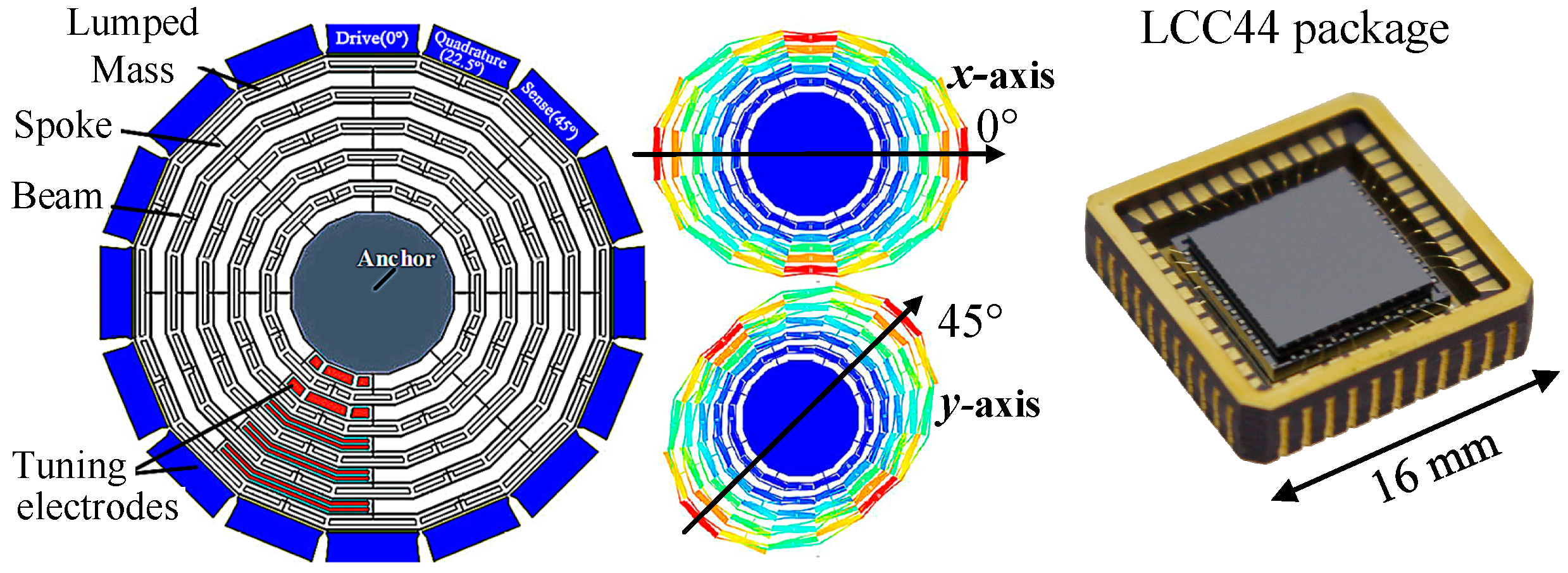
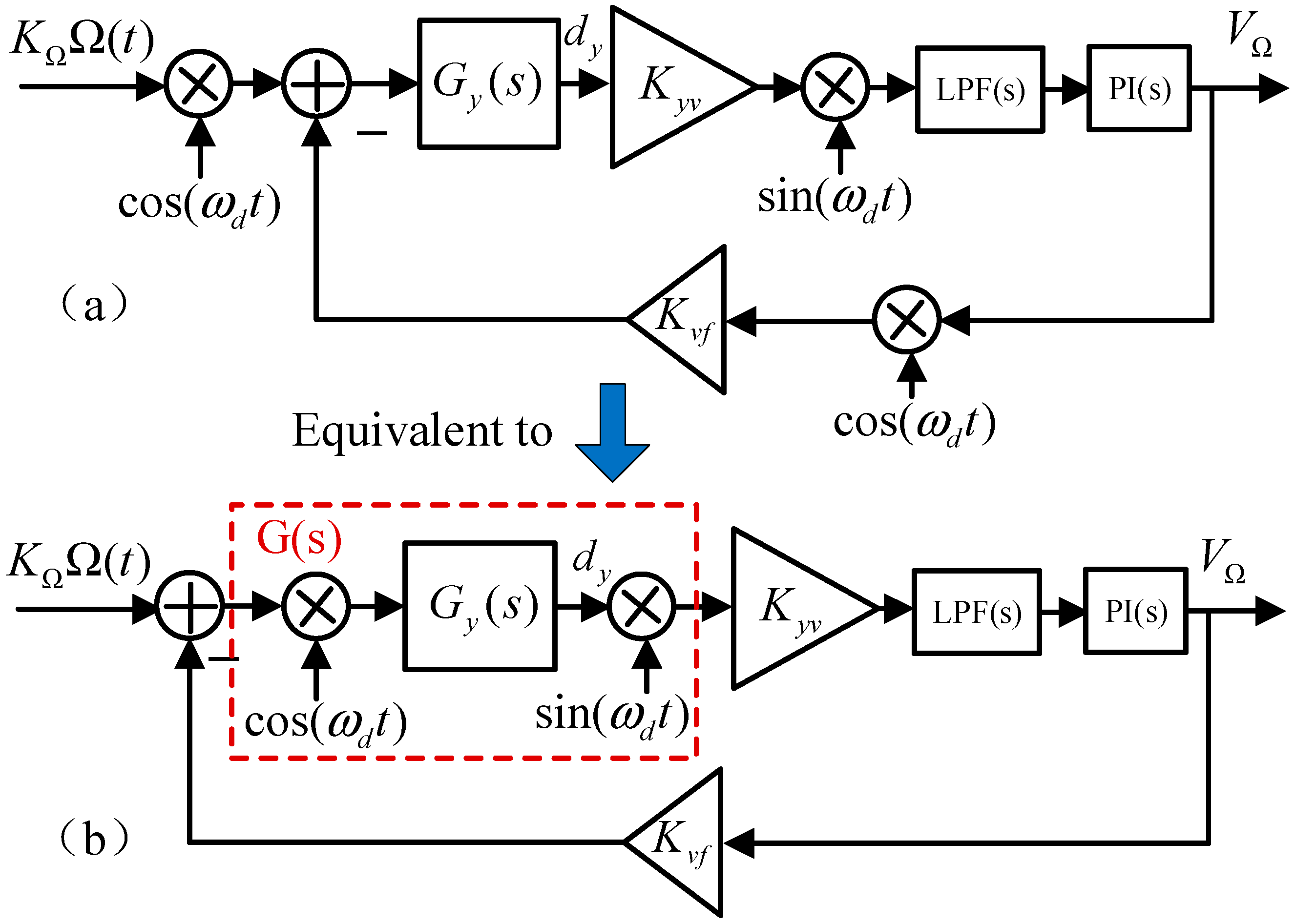
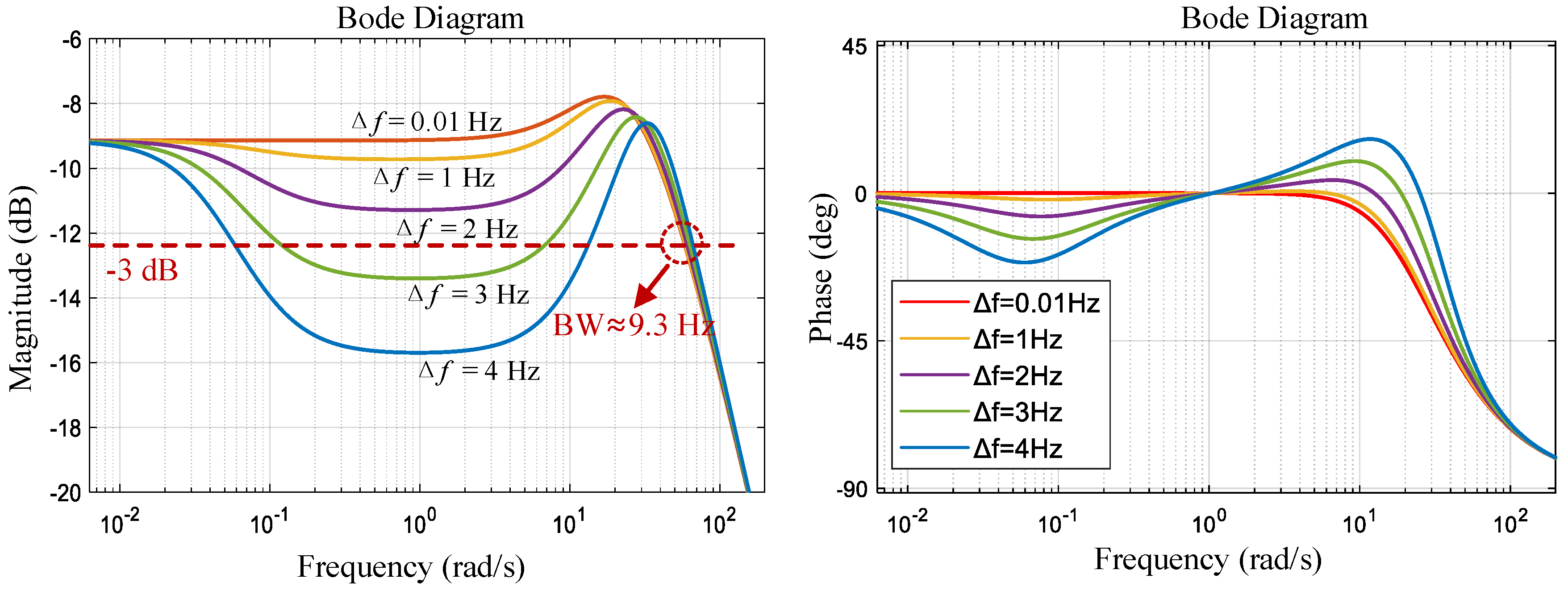
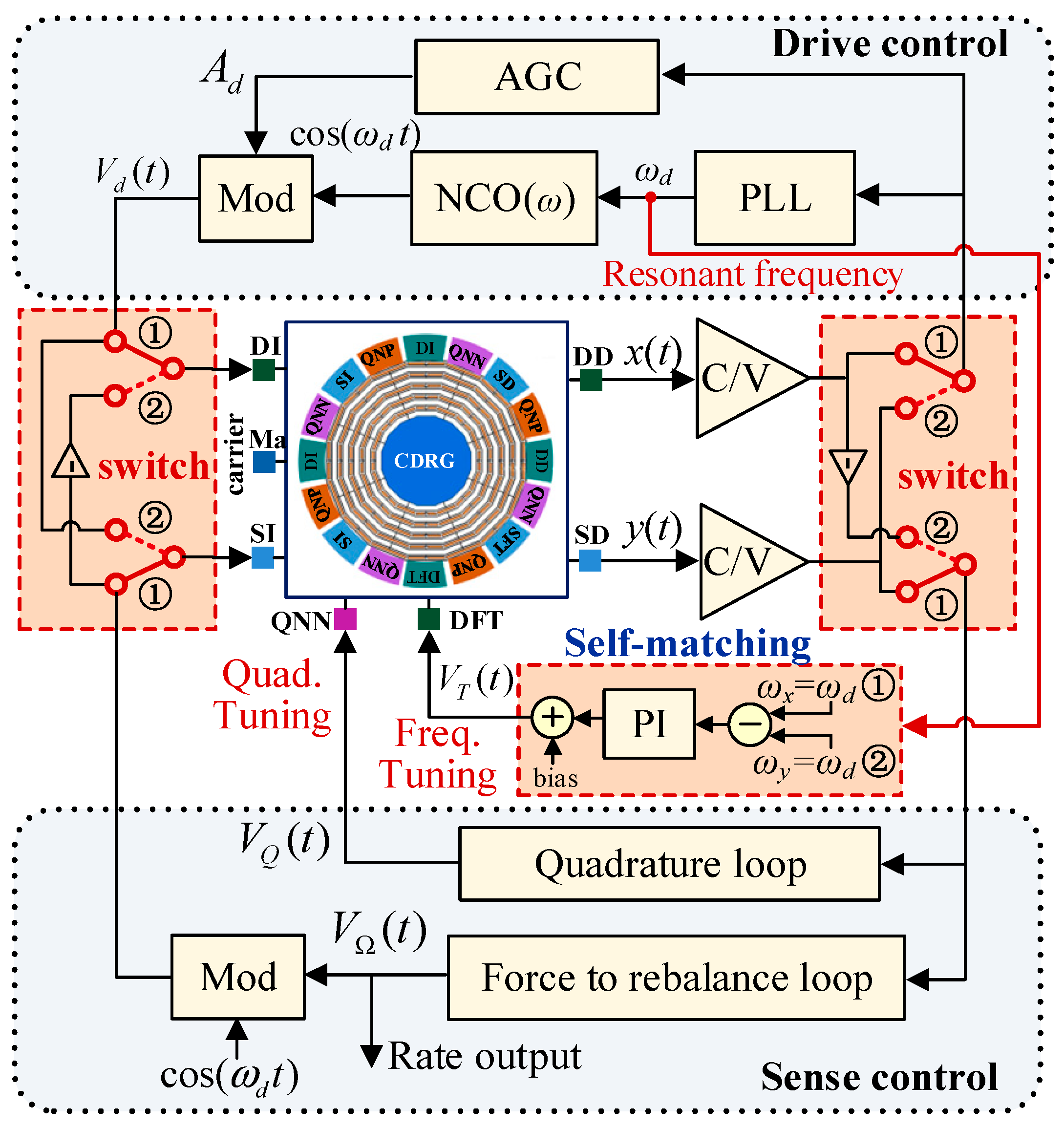
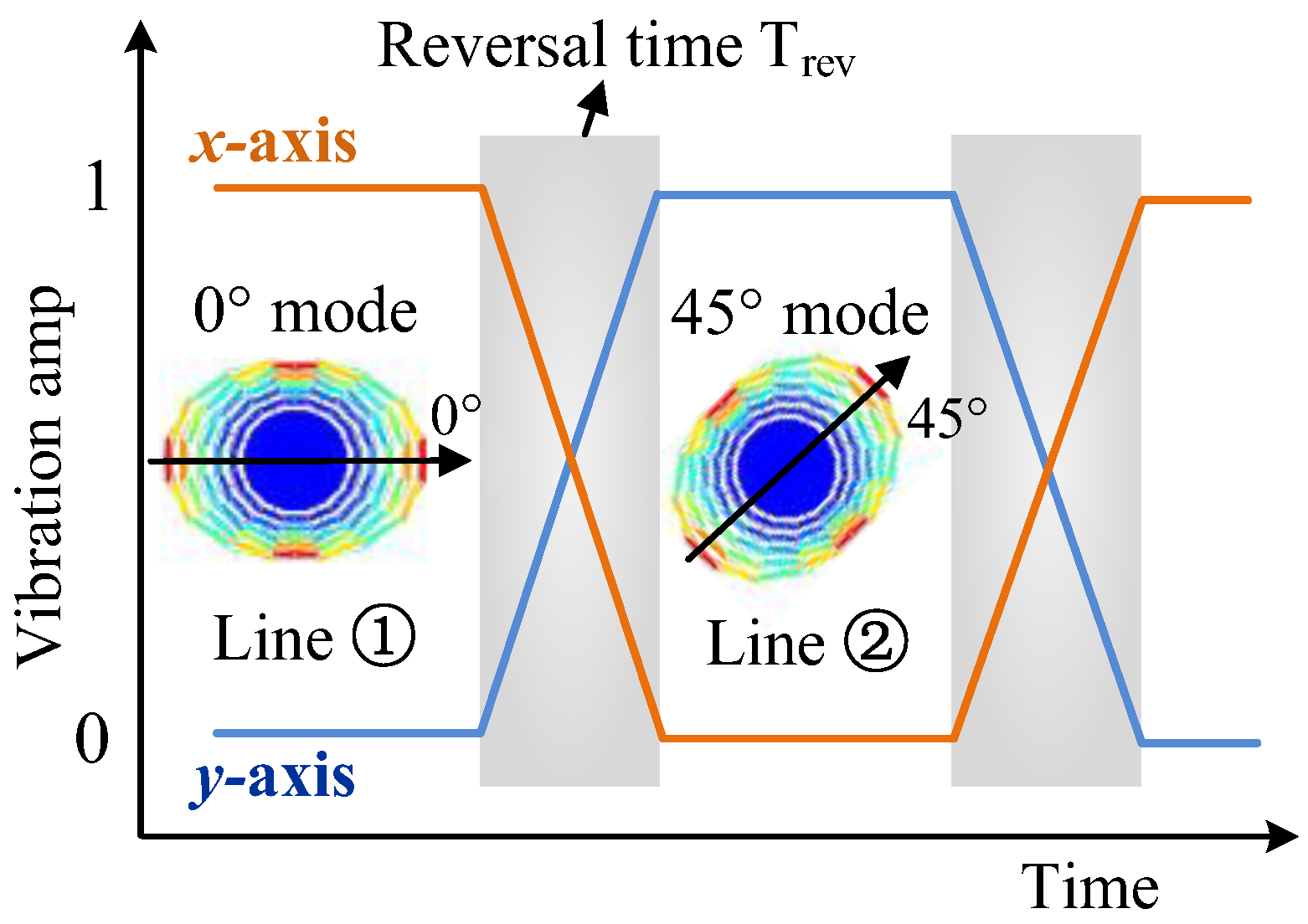

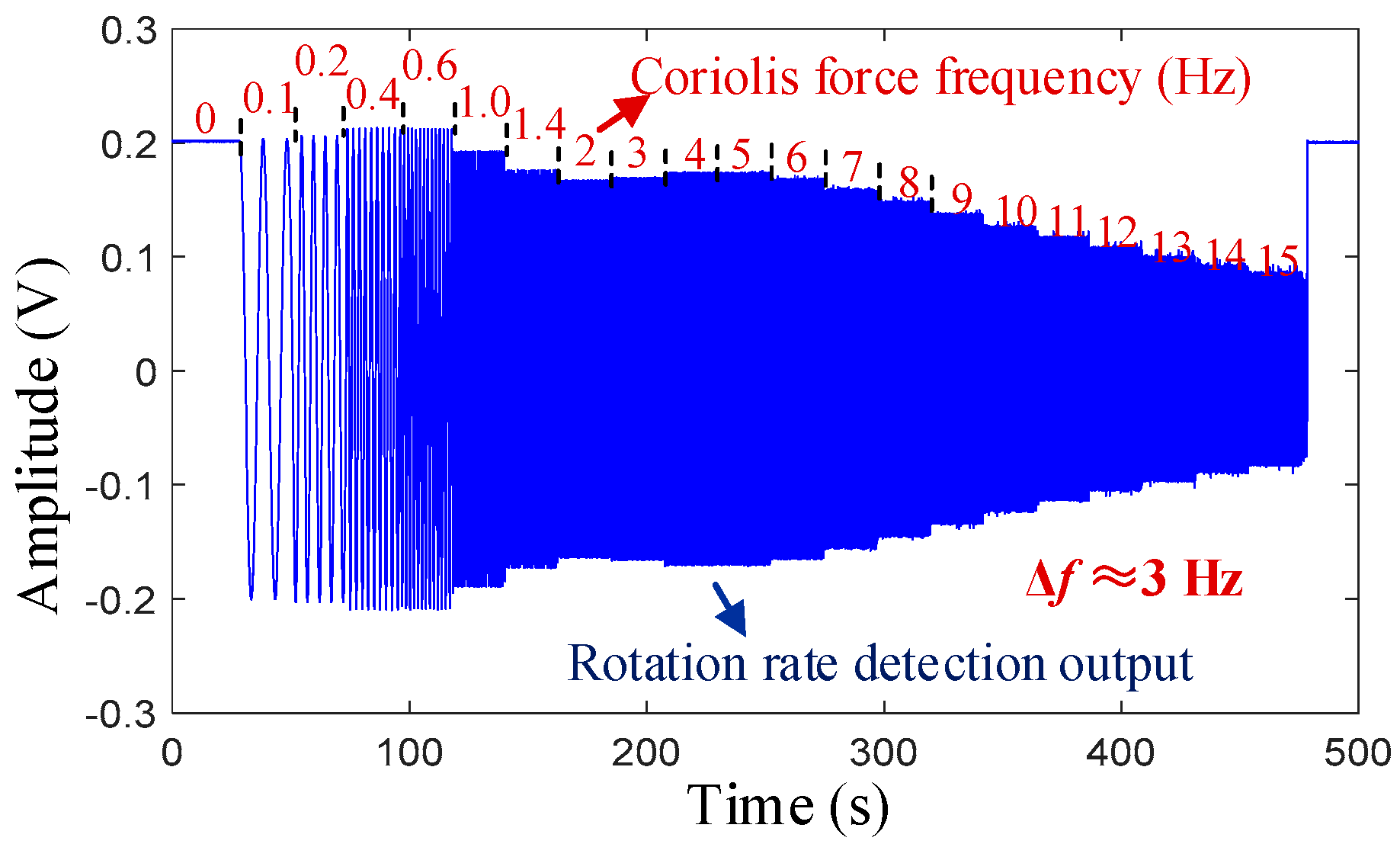
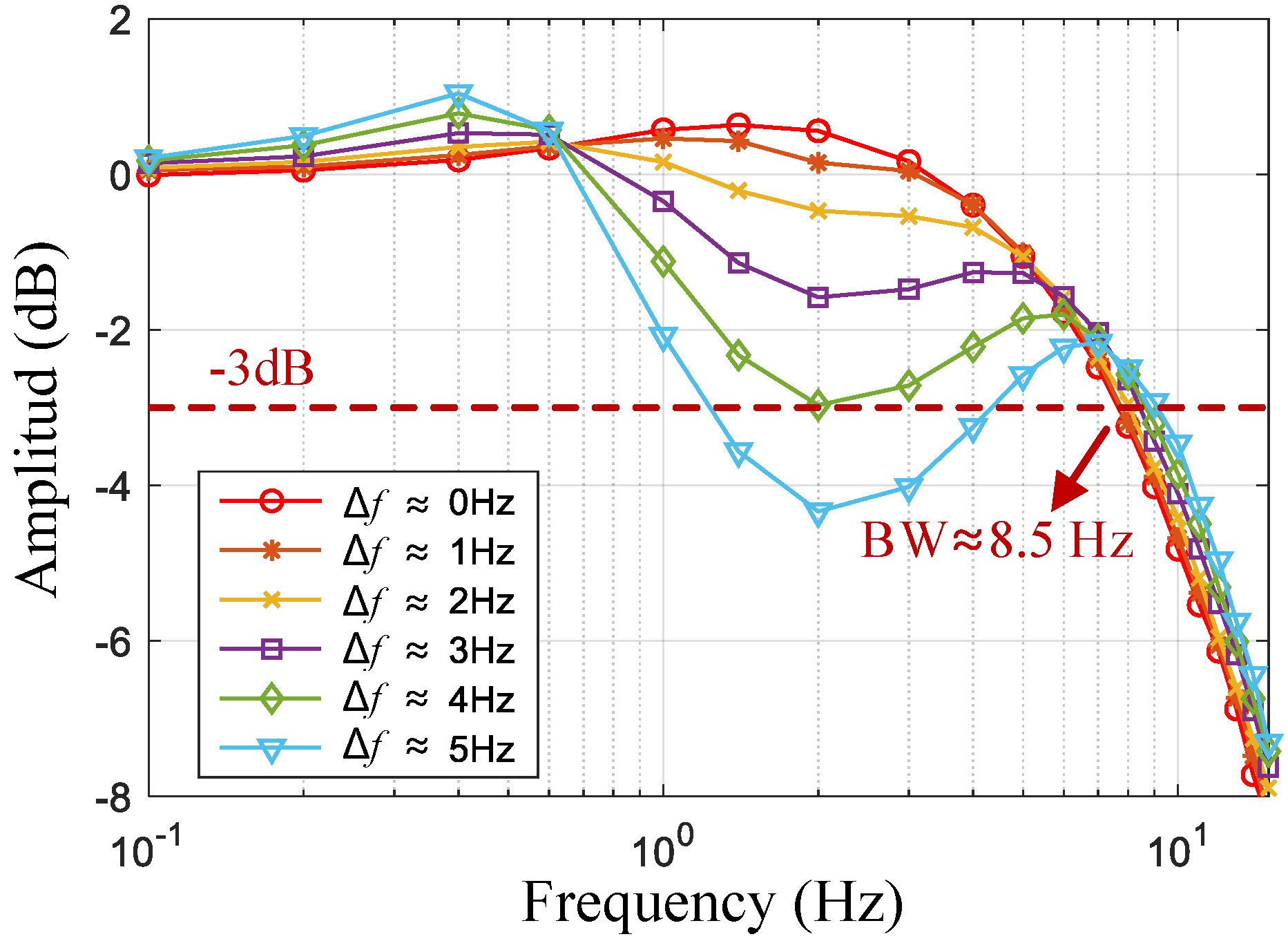
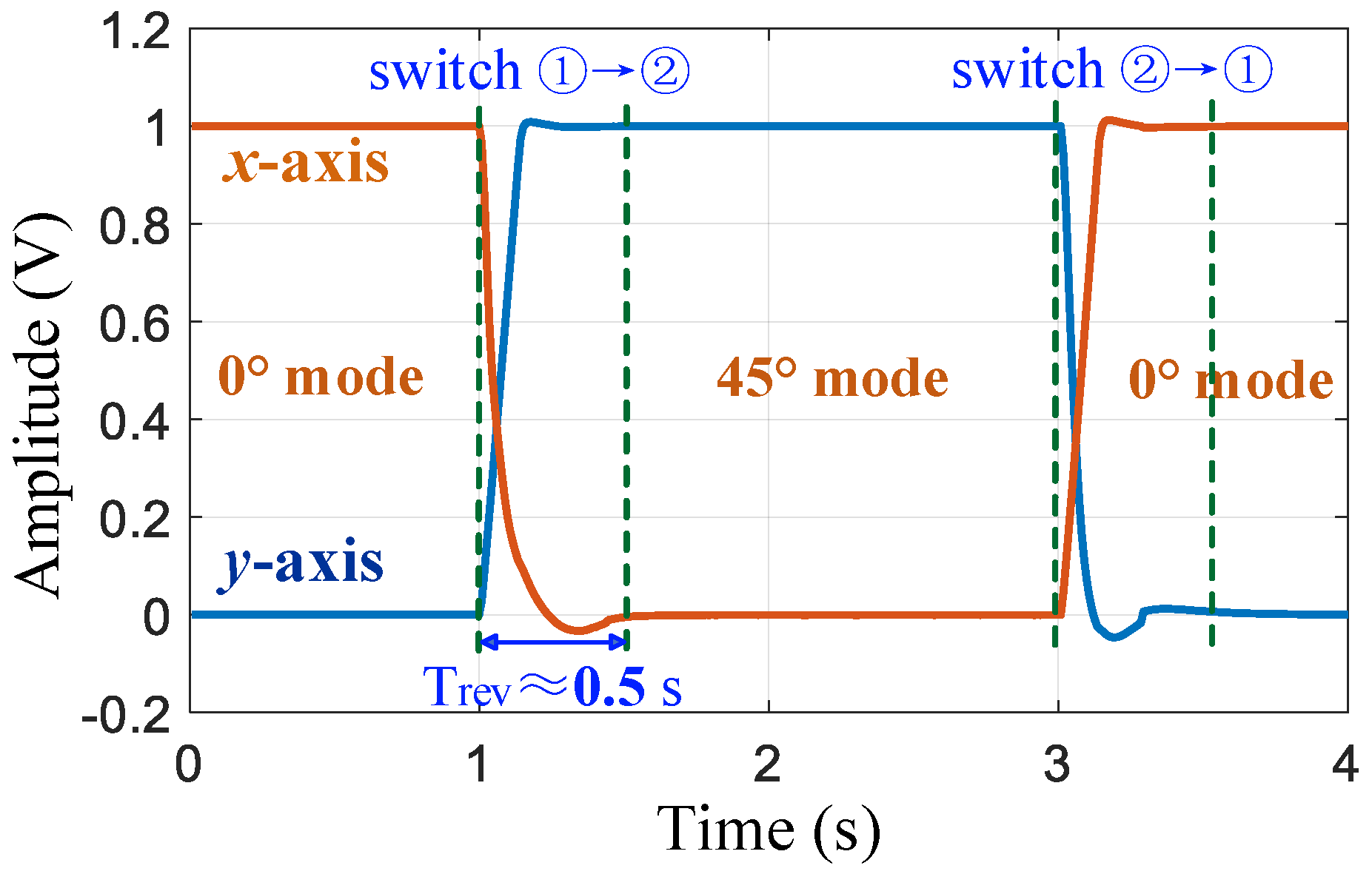

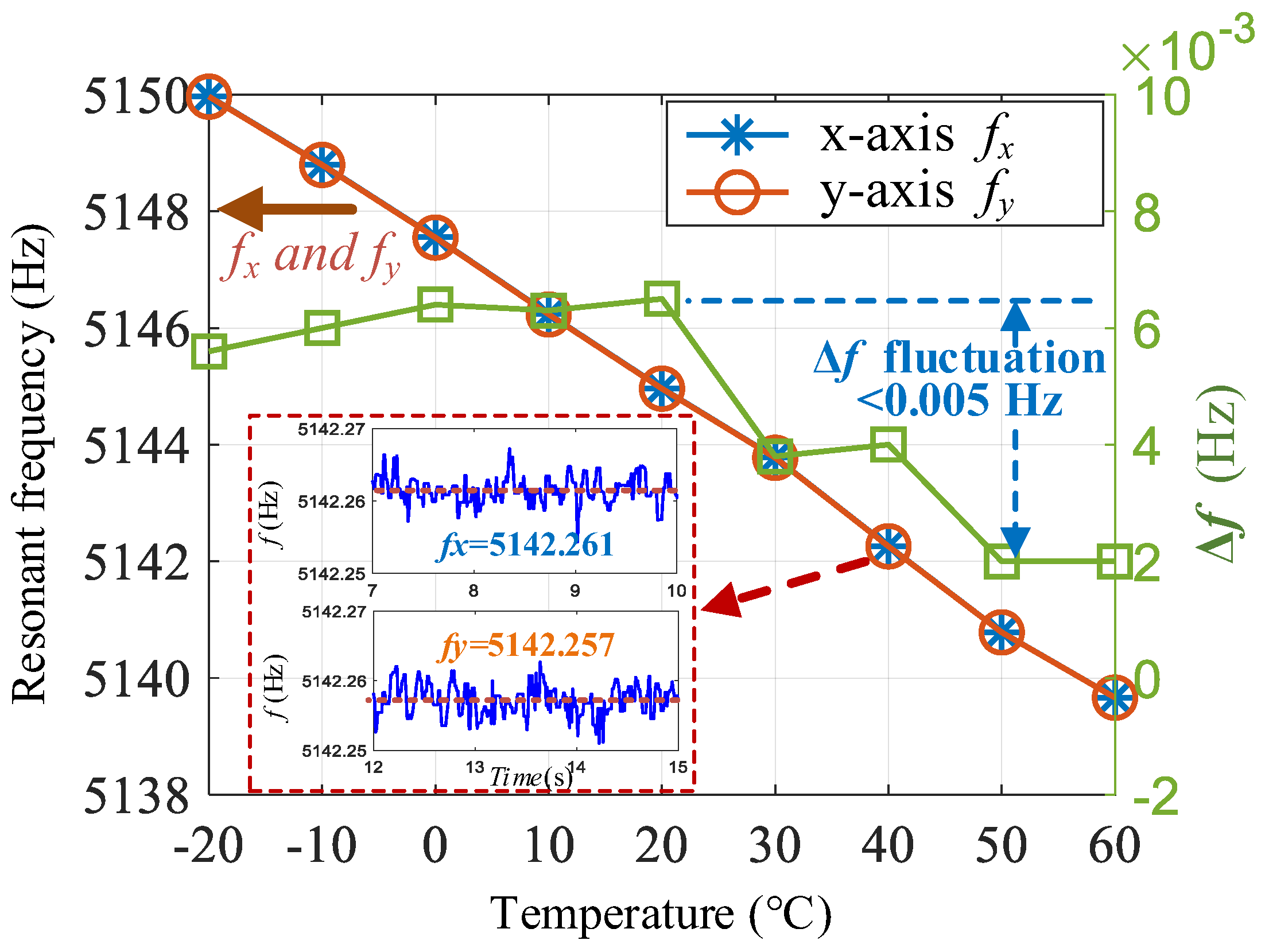
| Parameters | Values |
|---|---|
| Proof mass (m) | 0.46 mg |
| Parallel plate gap (g) | 7 um |
| Parallel plate capacitance (C0) | 2 pF |
| x-axis resonant frequency (fx) | 5144.3 Hz |
| y-axis resonant frequency (fy) | 5143.1 Hz |
| x-axis Q-factor (Qx) | 181.2 k |
| y-axis Q-factor (Qy) | 184.5 k |
| Carrier signal | 5Vpk@1MHz |
| Scale factor (SF) | 6.1 mV/°/s |
| Research Institution | Gyroscope | Tuning Accuracy | Technical Characteristics |
|---|---|---|---|
| Middle East Technical University [5] | Double-mass gyroscope | <1 Hz | Using phase between the residual quadrature and drive signals, one-time |
| Nanjing University of Science and Technology [10] | Disk resonator gyroscope | 0.094 Hz | Using phase-shifted virtual Coriolis force, real-time |
| Southeast University [11] | Disk resonator gyroscope | <0.1 Hz | Using virtual Coriolis force, one-time |
| Southeast University [12] | Double-mass gyroscope | 0.28 Hz | Using power symmetry of readout signal, real-time |
| Newcastle University [22,25] | Ring gyroscope | 0.006 Hz | Using response of an external force, one-time |
| University of California at Los Angeles [26] | Ring gyroscope | <0.08 Hz | Using mass perturbation, parametric resonator models |
| Proposed method | Cobweb-like disk resonator gyroscope | 0.01 Hz | Using fast mode reversal, one-time |
Disclaimer/Publisher’s Note: The statements, opinions and data contained in all publications are solely those of the individual author(s) and contributor(s) and not of MDPI and/or the editor(s). MDPI and/or the editor(s) disclaim responsibility for any injury to people or property resulting from any ideas, methods, instructions or products referred to in the content. |
© 2025 by the authors. Licensee MDPI, Basel, Switzerland. This article is an open access article distributed under the terms and conditions of the Creative Commons Attribution (CC BY) license (https://creativecommons.org/licenses/by/4.0/).
Share and Cite
Bu, F.; Fan, B.; Feng, R.; Zhou, M.; Wang, Y. Automatic Mode-Matching Method for MEMS Gyroscope Based on Fast Mode Reversal. Micromachines 2025, 16, 704. https://doi.org/10.3390/mi16060704
Bu F, Fan B, Feng R, Zhou M, Wang Y. Automatic Mode-Matching Method for MEMS Gyroscope Based on Fast Mode Reversal. Micromachines. 2025; 16(6):704. https://doi.org/10.3390/mi16060704
Chicago/Turabian StyleBu, Feng, Bo Fan, Rui Feng, Ming Zhou, and Yiwang Wang. 2025. "Automatic Mode-Matching Method for MEMS Gyroscope Based on Fast Mode Reversal" Micromachines 16, no. 6: 704. https://doi.org/10.3390/mi16060704
APA StyleBu, F., Fan, B., Feng, R., Zhou, M., & Wang, Y. (2025). Automatic Mode-Matching Method for MEMS Gyroscope Based on Fast Mode Reversal. Micromachines, 16(6), 704. https://doi.org/10.3390/mi16060704






